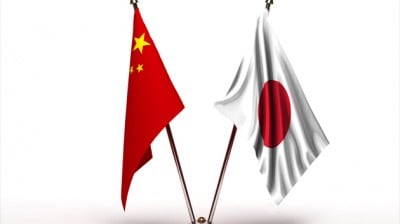China-Japan Arms Build-up
China plans to have four aircraft carrier battle groups in service by 2030

Two myths, that Japan does not have an aircraft carrier and that China is sticking with two, have just been torpedoed.
Chinese authorities confirmed on Tuesday that they were building the country’s third aircraft carrier. But it was hardly an iron-clad secret.
In June, the image on a publicity picture in the boardroom of China Shipbuilding Industry Corporation, the ship’s builders, in Wuhan City, showed three aircraft carriers, whereas Beijing only has two. The third was an artist’s impression of the one the corporation was building in Shanghai.
The two are the Liaoning, the country’s first aircraft carrier, refurbished from the hulk of a Ukranian vessel and the still-to-be-named Type 001A, undergoing sea trials since 2017 before coming into service in 2019. It is the country’s first domestically developed carrier.
Both have ski-jump decks, but the new warship will have a flat-top deck, suggesting a catapult aircraft launch system.
A large command center on the deck could indicate that the warship will be a conventionally-powered carrier rather than rely on nuclear-power.
Xinhua News Agency’s announcement of the project came in an article commemorating China’s first successful landing of a fighter on the Liaoning just after its launch in November, 2012.
China plans to have four aircraft carrier battle groups in service by 2030
Japan too is reinforcing its military capability. In November, China and Japan agreed to boost trade between the countries in response to Washington’s protectionist lurch. But both countries have a sizeable and vociferous military lobby. Japan is preparing to order another 100 F-35 stealth fighter jets from the U.S. to replace some of its aging F-15s.
China’s military build-up played a role in the decision as did pandering to U.S. President Donald Trump’s call for Tokyo to buy more defence equipment. Japan had intended to buy 42 new fighters but is now set to more than double its order. A single F-35 costs over $88 million.
This also means that one of the most ridiculous pretences of modern times will be sunk. The Tokyo government intends to revamp the Maritime Self-Defence Force’s JS Izumo helicopter carrier to host the fighters.

The Izumo (image on the right, CC BY 4.0), a 250-meter-long “flat-topped destroyer’’, was named after a cruiser that was sunk by the U.S. in 1945. The warship is in reality an aircraft carrier by any other name. However, aircraft carriers imply a force projection well beyond Japan’s shores, therefore it had to be described as a destroyer or a helicopter carrier.
That pretence will be dropped once some of the new vertical take-off F-35 jets in the 100-fighter batch purchased by Tokyo are deployed on the carrier.
Japan’s government plans to approve the purchase when it adopts new National Defence Program Guidelines at a cabinet meeting in mid-December.
The 42 fighters Japan originally planned to buy are all F-35As, a conventional takeoff and landing variant. The additional 100 planes would include both the F-35A and F-35B, which is capable of short takeoffs and vertical landings.
Perfect for the former helicopter carrier.
*
Note to readers: please click the share buttons above. Forward this article to your email lists. Crosspost on your blog site, internet forums. etc.
Tom Clifford is an Irish journalist based in China.

